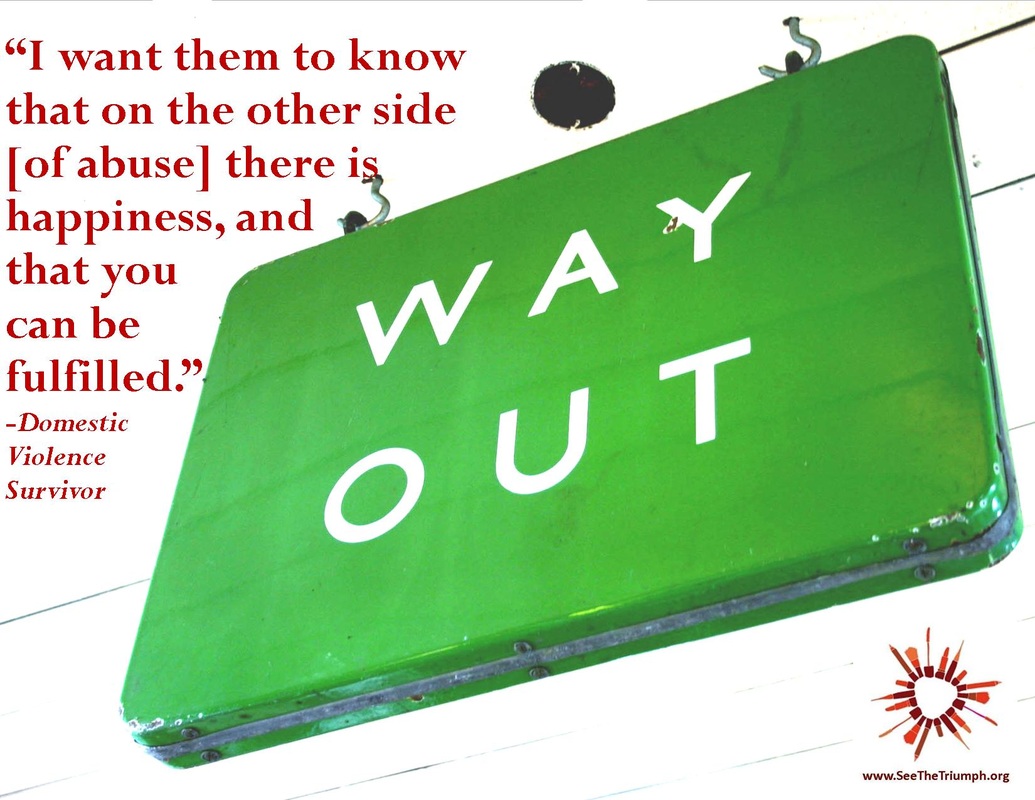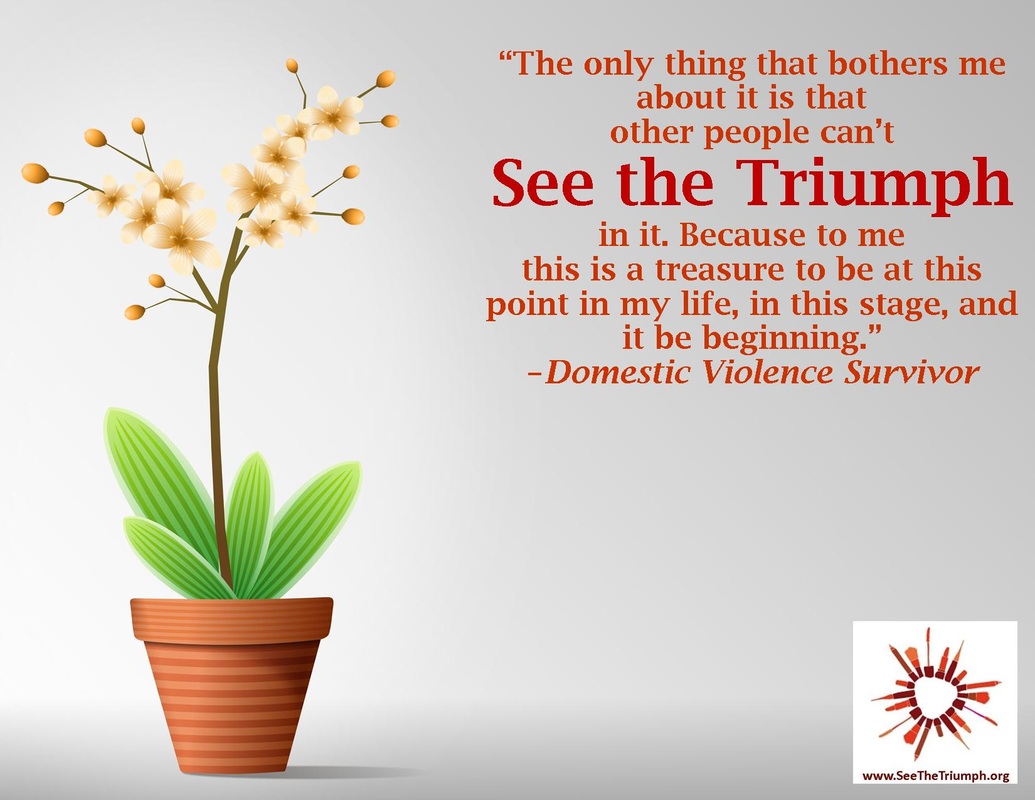|
By Christine Murray, See the Triumph Co-Founder
I know it’s not easy to know or suspect that someone you know is in an abusive relationship. It can be frustrating, scary, and challenging to know what to say or do in this situation. On the one hand, you want to help that person. But on the other hand, you also respect their privacy and right to make decisions for themselves. You may have tried to help in the past, but they weren’t responsive. You might not agree with the decisions they’re making to stay in their abusive relationship. Or, you might just not know what to say. Today, I want to share with you some stories from the survivors in our studies that show just how important it is to reach out to people who are being abused. Because this is Teen Dating Violence Month, for today I’m just focusing on participants who were in dating relationships (i.e., they said that they were in dating relationships or were in committed relationships but not living with their partners when we asked them to describe the highest level of commitment they had in their past abusive relationships). Of course, many survivors in other types of relationships, such as marriage or domestic partnerships, face similar experiences. However, following our theme of “It’s Teen Dating Violence Month: Let’s Talk!!!”, I wanted to focus today on the importance of reaching out to those who are experiencing abuse in dating relationships. Through our research, we’ve learned that isolation is a big part of the stigma surrounding intimate partner violence. This isolation can be so powerful that many people in abusive relationships come to feel that they have literally nobody they can turn to for help or support. Isolation was a very common theme for the survivors in our studies who had experienced dating violence. Let’s take a closer look at how that isolation can happen. First, the isolation can result from the abusive partner’s controlling behaviors. As examples, here are a few quotes from survivors of dating violence from our research:
And finally, some survivors find that when they reach out for help, the people they reach out to distance themselves or provide unsupportive responses. For example, one survivor said:
All of these factors can add to the isolation that dating violence survivors may encounter. I know it’s hard, but for all these reasons, if you know or suspect that someone you know is in an abusive dating relationship, reach out to them, don’t run away. Chances are, they are already feeling quite isolated and lonely. Be prepared that they may not initially want to or feel safe to do anything different to leave or change their relationship. This can be very frustrating to watch. However, you can send a powerful message to this person by letting them know: “You don’t have to face this alone.” By Quasona Cobb, See the Triumph Contributor
My name is Quasona Cobb, I am 24 years old and I am a teen dating violence survivor. I spent nearly four years in a tumultuous relationship and believed that I was the cause and the cure of everything that went wrong in the relationship. While physical violence was not always present, the threat of violence was there. At times I felt like I was skating on thin ice not knowing when my ex-boyfriend would lash out. Just days before the 2011 new year I ended the relationship and that night I literally found myself in a fight for my life. The next morning my best friend came to my apartment to help me pack up a few things and I broke my silence to my family. A few days after that, the same person that tried to end my life decided they would retaliate by brutally attacking my mother. As my mother began a slow recovery, I started to do my research on intimate partner violence and was shocked by my findings. The Centers for Disease Control and Prevention published a report in 2010 stating, “1 in 4 women will experience intimate partner violence in their lifetime and of that group, 1 in 5 will first experience it between the ages of 11 and 17.” I decided that our tragedy would not be in vain. I have participated in major magazine campaigns against dating violence, conferences, panels, walks, daytime tv shows, documentaries and a number of other awareness projects. In sharing my story I am asked a bunch of questions pertaining to my survivors perspective and my opinion about teen dating violence. There are six common questions that I am asked whether I am conducting an interview about relationship abuse or sitting on a panel. Below are the questions and my response. Were there any obvious signs that he was abusive? An abuser is not going to walk up to you and tell you that they are controlling, manipulative, and will cause you harm. Those characteristics come out later in the relationship. I met my ex-boyfriend when I was a junior in high school. He was attractive, charming, came from a family of accomplished people and he was very attentive to me. To a seventeen year old girl with her first real boyfriend, I thought that I found a great catch. Did you ever confide in someone about the abuse? If so, then whom? The only two people that I felt comfortable talking to about the abuse with was my best friend and one of my younger sisters. I spoke to my friend about the incidents of abuse, seeking her opinion. She always urged me to leave my ex-boyfriend. The only reason that I ever mentioned anything to my younger sister was to let her know if anything ever happened to me, he would be the person responsible. Did you ever report the abuse to the authorities? No, I never reported him to the police until the day that I actually left the relationship. I was too afraid to start up trouble with him and the police. I knew of incidents where the abusers come back angrier and will do more harm after filing police reports. Why didn’t you tell anyone in your family? I come from a line of strong and assertive women, and I believed that the label victim meant you are weak or less than. The fear of losing my life kept me silent. Self-blame, insecurities, and shame kept me silent. Not knowing if friends and relatives would look down on me if they knew of my status as a victim of relationship abuse kept me silent. The violence in the relationship not only affected you but also made an impact on your family. Have you ever experienced any guilt? My mom ended up critically injured by my ex-boyfriend, not only did I feel guilty, I was hurt and angry. My mom was intervening to help me and he took his frustration and anger out on her. Through therapy I learned how to let go of the self-blame. My ex-boyfriend is the only person responsible for his actions. After experiencing dating violence, have you dated again? The idea of dating was the furthest thing from my mind after leaving a violent relationship. I was very cautious with dating but I was more open to letting my family and friends into my dating life; I needed second, third and fourth opinions. I am in a new relationship and I have been for quite some time now. I feel safe and secure because we have communication and boundaries, two essential elements of a healthy relationship. Most of the workshops that I participate in are led by social workers and teen dating violence agencies. Their main objective is to hear from the survivors of dating violence so that they can design a program to reach out and better assist victims of violence. I use all aspects of my personal experience with dating violence to discuss the trauma, healing process, and the violence in the relationship in hopes to demystify the secrets of intimate partner violence. Note: We first learned about the Speaking Without Words dance video about dating violence in this news report. We love the creativity and vision that went into this work, so we are thrilled to share this guest blog today from Andrew Carroll, the University of South Florida Dance Professor who produced the video. You can view the full-length production here: https://www.dropbox.com/s/cl1q4zuq1t8b7x5/finalspeakingwowords.mp4. Thanks to Andrew for sharing his vision and ideas with us!
By Andrew Carroll, See the Triumph Guest Blogger Assistant Professor of Dance in the School of Theatre and Dance at the University of South Florida As a professor of dance at The University of South Florida, and as one who has spent his career immersed deep within the genre of dance, I have long believed that dance can express where words fail. Indeed, in this landscape of words, texts and new symbols created as a means of communication, movement has and always does exist to illustrate feelings, concepts and nuances on a deeper level of understanding. As an example, I often speak to my students to think of the three words “I love you.” We hear this phrase many times in our lifetime, and perhaps through repetition, the meaning can get blurred or understood only on a surface level through the reoccurring speaking of these same words. Yet, if an individual who truly loves you looks silently into your eyes, and simply reaches out to touch your cheek, the “feeling” of love or caring can be felt more deeply with this gesture of movement, than merely speaking the words. To this end, I was quoted in our USF Arts Calendar as stating that I believed art and/or dance exists where words fail, and only feeling exists. I have held this sentiment both as a performer as a soloist with The Pennsylvania Ballet Company, and now as a professor at USF’s School of Theatre and Dance. My research in the investigation of using dance via the vehicle of a dance music video to communicate stems from this belief. Specifically, my creative research agenda has been to develop a new language using dance in the architecture of social awareness and education. This agenda had its beginnings in a commission I received from The Florida Department of Health, who were interested in a new way to educate their cleaning staffs in proper protocols of C-Diff elimination (a spore that is present in hospital settings, and which is responsible for many illnesses). The FDOH was interested in a dance music video as the means to disseminate this information for several reasons: it was innovative, it had the chance to engage viewers through its use of a popular medium, and lastly, because dance was to be the “language,” it could be understood by any viewer. The FDOH research project was accomplished in 2011, which then led to two more commissions from this organization. Subsequently I began to envision that this medium of a dance music video could be very effective for the school age demographic, as dance videos occupy a niche of entertainment for this group. Therefore, advocacy, awareness and education of social issues might be illustrated valuably if implanted and conveyed through this same format. With this in mind, I applied for a grant in 2011 to produce a new video, but geared towards the issue of Bullying. The Bullying project video was produced in 2012 and surpassed my expectations as to the sheer volume of organizations world-wide who adopted it for use in their respective bullying programs. The success of the Bullying video inspired me to write a new grant in 2013, this time to produce a similar video, but geared towards Dating Violence. I was awarded the funding, and The Dating Violence, Recognizing Warning Signs video project began. The project was completed in August 2013, and by the end of 2013, it has been requested by organizations in Germany, Albania, Armenia, Greece, Belgium, Northern Ireland, Venezuela, Costa Rica as well as the Centers for Disease Control (The CDC) in Atlanta among others. Additionally, these two videos became feature stories on ABC, CBS and Fox National newscasts. As with the Bullying Video, I was fortunate to work with a professional crew of dancers who I handpicked as having the potential to carry off the required dance material in addition to the acting skills needed to portray the issues. The Dating Violence cast approached the work professionally, with the utmost respect for the topic issue. The process was hardest on the male lead who was asked to portray the role of the abuser. The act of aggression was not in his nature, thus he had to dig deep into his dance and acting skills to portray a character that was foreign to him. The rest of the cast, and specifically the female lead, worked diligently with me to experiment with movement phrases that best aligned with the concepts of an unhealthy relationship that I identified through research with the Love and Respect and 2in2u organizations who advocate on behalf of dating violence. Judy Chiasson, of The Office of The Chief of Staff for the entire Los Angeles Unified Public School System who adopted both videos, wrote in an email to me: “The use of dance as dialogue is especially useful as an educational tool for several reasons. Youth are so tired of having adults lecture at them. They get so much more out of a dance video than they ever get out of an adult lecturing. Many of our students express themselves with dance, so this is a media that resonates with them. They respond well to role models who are just a little older than they. So having college-aged dancers is a valuable. The absence of spoken dialogue allows them to draw upon their own experiences to "write" a dialogue that is personally meaningful in the language that they speak. We have 200 languages spoken in the District. Your dances represented some harsh situations that would be too disturbing to be viewed explicitly. I am thinking of your dating violence video. It was very sensitive that the acts of kindness were acted out, but the acts of violence were danced. For our students who are exposed to regularly exposed to violence, the dance expression made it safe to witness. I also like that your pieces all build resiliency and heroism. I will not show any bullying or dating violence piece that does show a positive resolution. Too often, people try to teach children by traumatizing them. There is a wealth of films, documentaries, YouTube videos, and PSAs that show horrific scenes, in a scared straight kind of tactic. I never show such pieces to our students. Your pieces are all positive and give hope and tools. Most of the materials that get marketed are missing those critical elements. “ I would like anyone who views either of these videos to not only take away messages that are imbedded within their constructs, but to also embody the experiences displayed to better understand the concepts on a deeper, physical level. It is my belief that the use of dance and movement can facilitate this process. I also believe that by using strong visual images, students can engage more in the process of learning about the subjects portrayed. This idea, coupled with the notion of the physical embodiment of feelings and senses displayed through dance can supply more investment in the process of awareness and education. This in turn can perhaps lead to a more fertile environment for discussions and dialogues pertaining to bullying and dating violence. |
Archives
July 2024
CategoriesAll About Intimate Partner Violence About Intimate Partner Violence Advocacy Ambassadors Children Churches College Campuses Cultural Issues Domestic Violence Awareness Month Financial Recovery How To Help A Friend Human Rights Human-rights Immigrants International Media Overcoming Past Abuse Overcoming-past-abuse Parenting Prevention Resources For Survivors Safe Relationships Following Abuse Schools Selfcare Self-care Sexual Assault Sexuality Social Justice Social-justice Stigma Supporting Survivors Survivor Quotes Survivor-quotes Survivor Stories Teen Dating Violence Trafficking Transformative-approaches |
Search by typing & pressing enter










 RSS Feed
RSS Feed